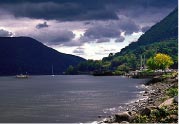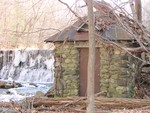 |
| May 05, 2024 |
Welcome! Click here to Login
|
 |
|
|


|
|
|
Click to visit the
Official Town Site
|
|
|
|
|
|

|
| Ruins of the first water station |

|
| The village's well field in Mountainville |
February 01, 2007
Part Two of a Water Series
(Part One, click here)
Once the Black Rock water filter plant comes online, the reservoirs in the forest will once again become Cornwall-on-Hudson’s primary source of water for the system that serves just over 2,500 customers in the Cornwall area, According to Mayor Moulton, Black Rock’s addition will be the final piece in a uniquely flexible system that draws on three separate water sources.
In an interview recently, Mayor Edward Moulton spoke about the development of the Cornwall-on-Hudson water system from its inception through rapid expansion in the past four decades, an expansion paid for in part by Con Edison, which was trying to build its power plant on the side of Storm King Mountain. (Read more about the epic environmental battle at Storm King.)
Con Edison Proposes a Power Plant
Con Edison had its eye on the Black Rock reservoir system when it came to the village in 1962 with a proposal to build a hydro-electric plant. Con Ed planned to build up the upper reservoir to a mile in width and use it as a holding area for water that would be released through a tunnel down the mountainside to create hydro-electric power at peak demand times. Many in town welcomed the power company giant, including the town and village officials at that time. They saw a source of tax revenue and an investor in public works.
“It would have been a great boon for us tax-wise,” Mayor Moulton recalls. “I think we got a lot of benefit out of it even though they didn’t build it. We got the water improvements, the filter plant.”
19th-Century Water System in Black Rock
The village had been getting its water from Black Rock since village residents on the mountain first tapped into the clear water that flowed from Black Rock Brook. Several families got together in the late 1800s and built a small dam and water plant not far from where today’s filter plant sits. The ruins can still be seen today.
Eventually, according to Mayor Moulton, the families that owned the system offered it to the town, which turned them down, and then to the village, which accepted the offer. That, Moulton said, is how the village first became the developer of the water supply for the entire Cornwall area. Throughout the first half of the 20th century, the village kept expanding the reservoir system, creating five in total. By the 1960s, the water department provided service to residents of the village and the expanding town.
Con Edison Develops Village Water Supply
Mayor Moulton said that in return for access to Black Rock water, Con Edison offered to upgrade the Cornwall water distribution and build a state-of-the-art filter plant in West Cornwall that would be fed by New York City's Catskill aqueduct, which ran right nearby
“They did a lot of improvements to the village water system in anticipation of the village giving them the upper reservoir in exchange,” Mayor Moulton said.
In 1967, Con Ed reported that it had spent $2.5 million for improvements to the Cornwall water supply system. It dug two wells in Mountainville that function as a vital part of the water system today, important because well water does not have to be filtered. Moulton said that the power company also built a “Cadillac” of a filter plant “that was not connected to anything. It was just there.”
Village Wins Access to NYC's Catkskill Aqueduct
While environmental groups formed to fight the power plant in court, Con Ed continued its projects in Cornwall and Cornwall-on-Hudson. It went to court on behalf of the village and successfully sued New York City for the right to tap into the Catskill aqueduct in 1974. Following that, the West Cornwall filter plant hooked up to the aqueduct and other municipalities along the path of the aqueduct followed Cornwall-on-Hudson’s lead.
The mayor recalled that by the time he was elected trustee in 1977, Con Ed had started digging the tunnel up to Black Rock, got rid of several houses along Route 218 and acquired the riverfront, where the company leveled the old factories and saved one building, the old Seaman’s Chapel, which still stands today. Opponents got an injunction and the project never moved further ahead.
Three Sources of Water Until 1996
By 1980 or so, Con Ed started withdrawing from the project and when Mayor Moulton was elected to his first term as mayor in 1981, he negotiated the donation of the riverfront park to the village.
For the next fifteen years, the village water system served Cornwall needs easily, drawing on the wells, the reservoirs and water from the aqueduct.
The next major wrench in the gears was the new federal standard for drinking water that called for filtration of the reservoir water from Black Rock. The pipes from the reservoir were shut off in 1996 and only now are getting back on line.
Comments:
No comments have been posted.
Add a Comment:
Please signup or login to add a comment.
|
 |
|
|
|